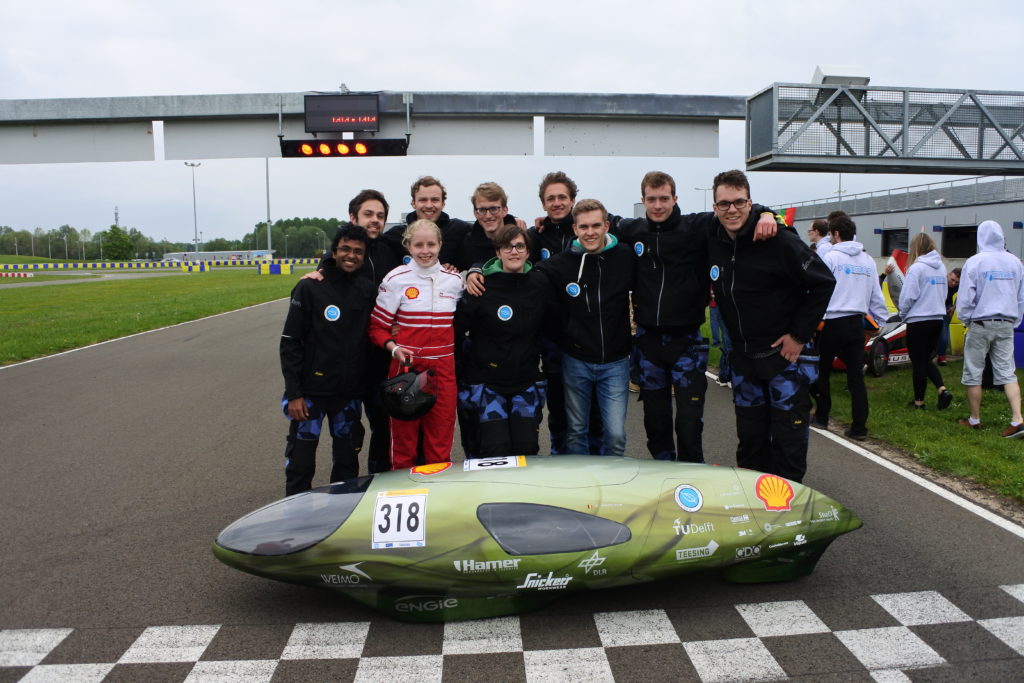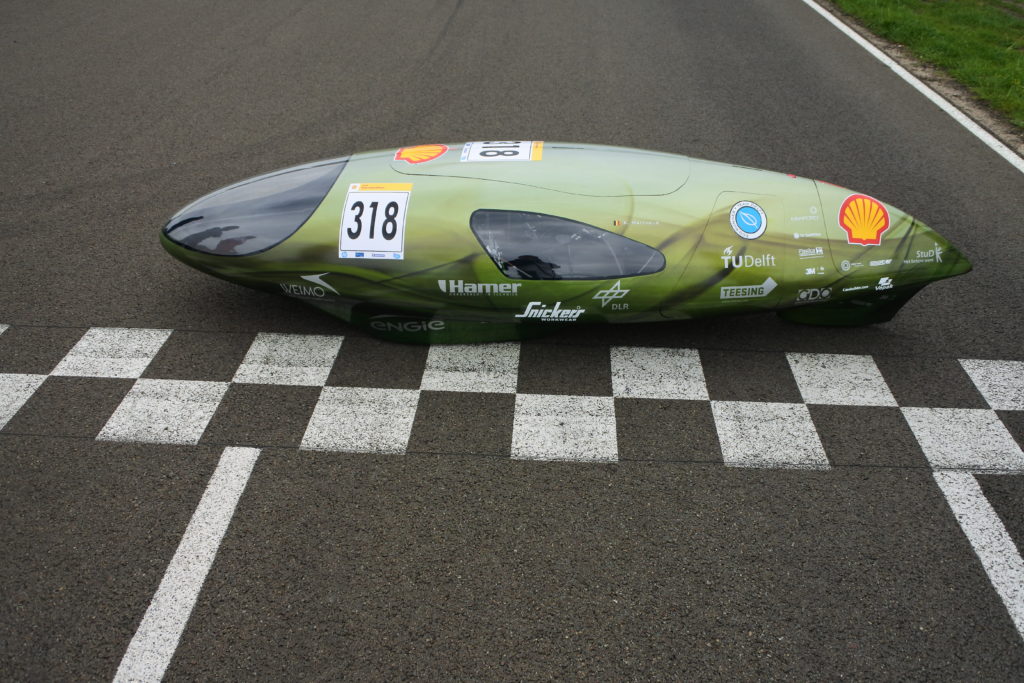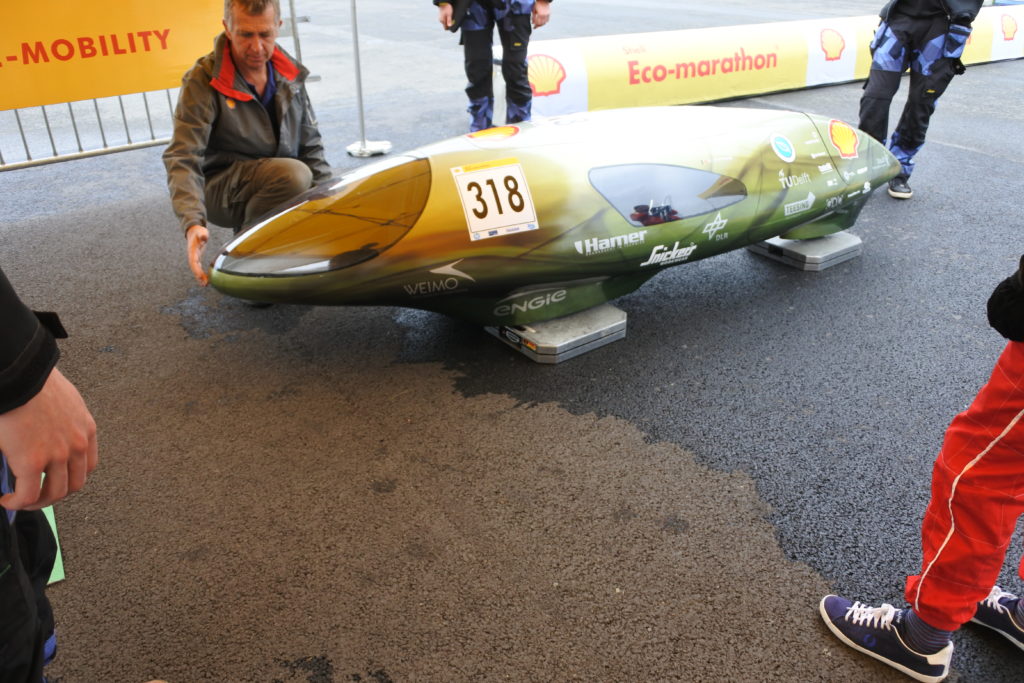The Eco-Runner competes in an annual event called the Shell Eco-marathon. A staggering 3000 students, spread over 200 student teams from all over Europe, compete in different classes within the competition. The Eco-Runner is a novel car designed to compete under the category of one of the most futuristic engineering concepts: cars using Hydrogen as its energy source.
From Delft to Moscow and back, on one liter of hydrogen? What was deemed once impossible is not so anymore. Team Eco-Runner has been successful in achieving this goal and has remained a consistent performer at the Shell Eco-marathon. This marathon is one of the premium competitions in the world that attracts many engineering students to put their skills and knowledge to the test. The task of the event is to construct a car that is as efficient as possible and covers a maximum distance using only one liter of Hydrogen for power.
The Eco-Runner team was formed ten years ago. They first competed at the Shell Eco-marathon on the Rockingham Speedway in the UK in July 2006 and have been perfecting their design ever since. They have proven to be unrivalled champions so far. Last year, they won the Shell Eco-marathon in Rotterdam with a result of 3653 km/L (energy in hydrogen converted to energy in liter gasoline). This dream project was realized by three aerospace engineering students. It was a project undertaken by them as a part of their graduate studies and thus, the first Eco-Runner was born. It was later given the status of a dream team amongst the many at TU Delft. This year, the 10th team is working on the sixth vehicle. A new team is formed each year and the recruitment begins in the early weeks of September. The team consists of students (both undergraduate and graduate) from varying engineering disciplines such as aerospace engineering, mechanical engineering, electrical engineering etc. This new team designs, simulates, develops, and tests their new vehicle each year.

The Eco-Runner year is roughly divided into three phases. The first phase consists of the design of the new vehicle. The design is altered each year, starting with a better performing aerodynamic shape, a new suspension and a custom made fuel cell. Aerodynamics and body design play a vital role in this phase. The second phase is the actual production of the car. Some parts are produced by specialized companies and the other parts are produced by the team members themselves. Most parts of this project are produced at the D: Dream-hall. The Dream-hall, located on the campus of TU Delft , provides the team with multiple milling machines, lathes and other machining and nishing equipment needed for the production phase of the car. During this period, a large part of the team spends their time behind production equipment. The last part of the Eco-Runner year consists of the race, which will take place in London this year.
The team consists of different departments, each responsible for a different aspect of the project. The departments are assigned their own managers, who are in turn responsible for the task completion of their team members. The different departments are cover body design department, suspension department, fuel cell and powertrain department, finance, PR and sponsoring department. Given below are the tasks carried out by each team as described by the respective managers.

SUSPENSION
The work done by this department is further subdivided into the front and rear suspension system, the wheels, the braking system and the steering system. Their main goal is to optimize the vehicle for minimum rolling resistance and produce a lightweight design since the components involved in the suspension of the vehicle are the major contributors to the total weight of the car. The suspension system performs the task of connecting the wheel to the body of the car, and its design is optimized using FEM (finite element method) software. The front suspension is made of aluminum. The rear wheel is enclosed in an aluminum cage, which is then attached to the body of the vehicle with carbon tubing.
The wheels are made of carbon fiber and are produced by the team at the Dream-hall workshop. The production for each wheel lasts up to three weeks. The tires are designed with the specific intention of attaining minimum rolling resistance with a coefficient of only 0.00081, thus obtaining higher fuel effciency. Further enhancements in wheel performance are achieved by setting an optimum Toe-in angle.
The steering system is used to navigate and change the attitude of the vehicle. They are designed following the principles of an Ackermann-mechanism so that the wheels always have an optimal position when cornering. The braking system of the vehicle makes use of disk brakes, which are easily adjustable and lightweight. They can maintain the vehicle in a stationary position even on a 20% inclination.
POWERTRAIN
The powertrain department comprises of four divisions: fuel cell, motor, the boost-caps and electronics. These divisions are managed by the manager of powertrain, who is also the fuel cell engineer in the current team. Within the fuel cell division, the focus this year is to develop and design a control system for a new fuel cell stack the team has obtained. In previous years, the control system came with the stack, but a system that is designed in-house allows for more optimization, which is beneficial for car efficiency. One of this year’s innovations within the team is the implementation of ‘boost-caps’ in the powertrain, which will serve as an energy buffer. Any superficial energy produced by the fuel cell will be stored in this buffer, and when the motor requires a lot of power, this energy is released to relieve some of the strain on the fuel cell.
Finally, the electronics and motor divisions work on the driver interface and car telemetry. The electronics division installs the various sensors and data-logging systems in the car, while also working on the driver control system with motor division. This division also ‘connects’ the motor to the rest of the pow- ertrain.
BODY
This department is responsible for the aerodynamics and structural integrity of the vehicle. The aerodynamic design is the most important design aspect during the first period and a wind tunnel test is scheduled in December. The Eco Runner design makes use of an optimization script for the top view of the vehicle in order to generate a shape, which accommodates all the subsystems. Subsequently, three-dimensional shapes are generated to perform a CFD performance simulation of the designs. Upon attaining satisfactory results, the first measurement data of the new vehicle is generated. This whole process is done in close cooperation with the needs of other departments in order to integrate various sub-component dimensions and safety margins that need to be met.
Following the design of the vehicle’s exterior is the design of the internal structure and the laminate lay-up of the vehicle. This is done using FEM software, Patran. The vehicle and its structure are modeled as shell elements due to the use of thin laminates. This department faces several design optimization challenges while ensuring the demands from other departments are met to satisfaction, making the engineer involved well-versed in CATIA and Patran.

RESEARCH AND INNOVATION
After achieving the wonderful result of 3653 km/L in May 2015, a new team was formed to try and achieve an augmented performance and lower fuel consumption. The team’s ultimate goal is to achieve a fuel consumption above 5000 km/L, by using hydrogen as the main power source. To attain this result, performance losses are looked at in three main categories: Rolling resistance, aerodynamic drag and the powertrain.
The rolling resistance depends mainly on the weight, meaning that every year, the vehicle is optimized for lower structural weight. The latest model of the Eco-Runner weighs less than 38kg. However, the largest part of the total weight comes from the driver, which, according to the Eco-marathon regulations, may not be less than 50kg. The drivers usually have to lose a few kilograms to achieve this weight. This year onwards, a special team of dieticians have been added to the team to ensure the drivers lose weight in a responsible and healthy manner. The tires of the vehicle, which are prime contributors to rolling resistance, are custom made Michelin tires, with the lowest measured rolling coefficient for its size.
After optimization of the aerodynamic shape in November 2015, the current team quickly realized that the performance could be further enhanced by adapting a new optimization strategy and by implementing novel research results on ow techniques, such as turbulators, to delay flow separation. Furthermore, the vehicle has been laminated as a whole, thus preventing any corrugations that might arise at the point of intersection of carbon fiber body and windscreens. The effects of this was tested at the Open Jet Facility (OJF) in May 2016.
In the powertrain department, a new hydrogen fuel cell system is being developed, that has the capacity to effectively distribute the energy around the track. This is done by implementing a pulsing system. Research is also done in optimizing the driving strategy. In combination with the new fuel cell, a new strategy has shown a decrease in fuel consumption by over 10% in comparison to the year before. Theoretically, the team believes that this should be well enough to achieve the goal and win the Shell Eco-marathon. To test the vehicle as a whole, the team will enter a test phase prior to the competition. This phase will take about 2.5 months during which the design will be verified and checked if it meets the competition requirements.

